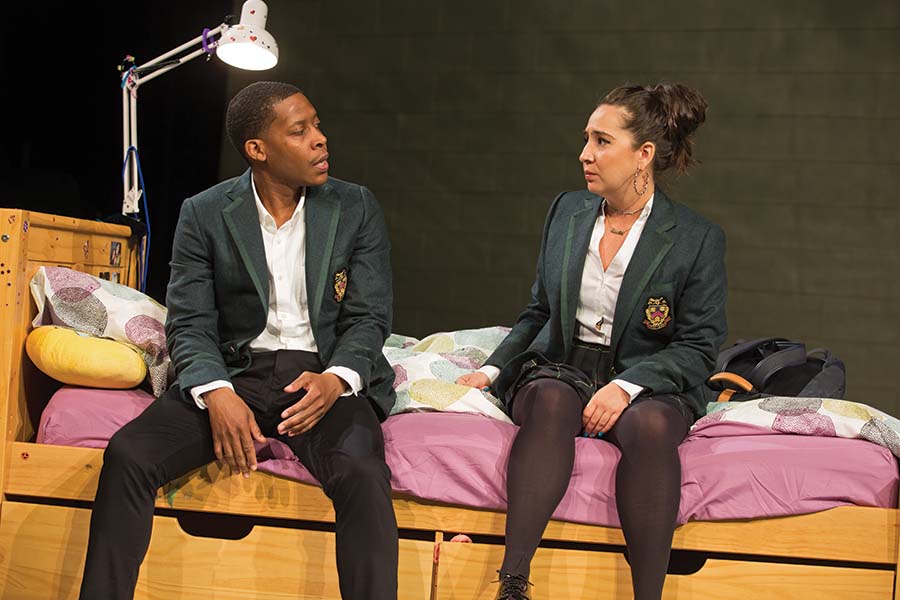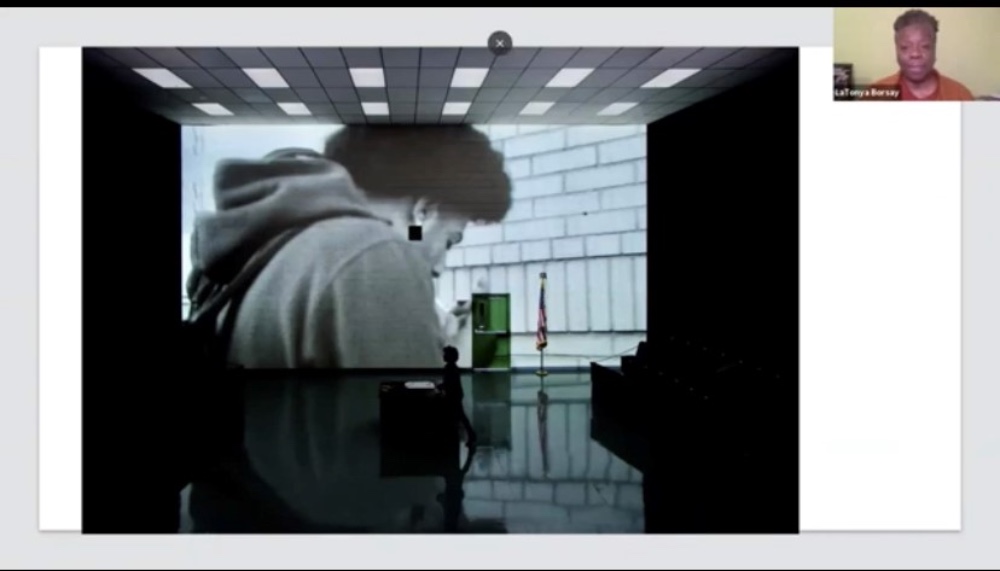When Lincoln Center Theater shut down their in-person operations in March 2020, they joined a host of other nonprofit and commercial theatres in shifting production calendars. Plays and events moved to the fall, then to this coming fall, and whole seasons of digital works needed to be cultivated at record speed. LCT’s education department, meanwhile, was desperate to keep the Open Stages program alive, knowing that up to 15 public high schools were relying on them for arts education offerings.
There are myriad studies about the benefits of arts education in schools, from providing creative outlets for students’ emotions to decreasing the number of students who leave school before graduating. But when the coronavirus first ravaged New York, arts educators had to adapt hands-on classes to remote learning. Students across the country have learned how to sing in virtual choirs and perform scenes with partners they can’t touch, while teachers have struggled to invigorate classrooms from afar and provide students with a reprieve from the monotony of online schooling. Meanwhile, arts professionals and observers have been debating the widespread use of digital offerings almost nonstop since last spring: Is something really theatre if it’s not happening live and in the flesh? What we’ve talked about less is what it means when digital theatre is a young person’s first experience with the form.
“Many of our students have never been to see a live theatre performance before,” LCT Hiltz director of education Kati Koerner (she/her) says. It’s easy for a seasoned theatregoer to picture themselves in a tight-packed audience when watching a filmed performance; it’s much harder if theatre is only someone you’ve heard about. “The biggest challenge is just engaging with the play at all, because you don’t have that frame of reference. Will a kid sit in front of their computer for an hour and a half and watch a play online?”
To make the process more engaging and intuitive, Koerner and the education department wanted to design an interactive dramaturgical website to offer alongside a filmed production. Looking through the archives, Dominique Morisseau’s Pipeline seemed a perfect fit: Lileana Blain-Cruz’s production ran in the summer of 2017, when students were away from classrooms and the Open Stages program, and Koerner had always regretted that students couldn’t participate in pre- and post-show activities. “It was such a perfect show for New York City high school students in particular,” Koerner says. The website explorepipelineplay.com, launched right after Thanksgiving, featuring at-home activities and lesson plan complements, as well as filmed insights from Morisseau and the cast and crew of Pipeline.
Set at an unspecified urban public school, Pipeline follows teacher Nya and her son Omari, who attends a private school somewhere upstate. When an “incident” threatens Omari’s future, Nya is plagued by anxiety that he will be expelled and become another Black teenager swept into the school-to-prison pipeline, a term for the direct relationship between harsh disciplinary actions at school—often at the hands of law enforcement officers assigned to the school—and the system of mass incarceration, which disproportionately affects men of color. Nya’s fear is not unfounded: In 1998, the New York City Department of Education (DOE) transferred disciplinary and safety enforcement powers in schools to the police, and the numbers of officers in schools skyrocketed; by 2020, the NYPD had added almost 2,000 school safety officers.

All of this information is available on the site, which combines statistics and analysis with links to relevant podcasts, news articles, reading lists, video exercises from teaching artists, and downloadable worksheets for the classroom. The site hosts activities designed for various teaching apps for what Koerner hopes offers “maximum flexibility” for interested high schools across the city.
It’s also fully optimized for mobile use, ensuring that students whose only internet access is via a smartphone or tablet can still participate in class activities. This was a crucial factor for the Open Stages team, as one component of de facto school segregation today is the digital divide, the gap between who has access to information technology and who does not—a gap that affects roughly 6 in 10 Black Americans and more than 5 in 10 Hispanic Americans.
LCT cannot singlehandedly tackle the digital divide through its theatre education programs, especially as the bureaucracy of the DOE feels more entrenched than ever, with debates over reinstating in-person learning heating up each day and dominating the news cycle. What LCT can do, through a combination of dramaturgy and web design, is teach teenagers about academic concepts like de facto school segregation in a way that’s accessible, relatable, and digestible. The site centers the experiences and voices of young people, including the work of Teens Take Charge, a diverse coalition of NYC high school students who lead desegregation campaigns targeting government and DOE officials. Their current goal is to repeal the state’s Hecht-Calandra Act, which stipulates standardized testing as the only admissions factor at all but one of the city’s famous specialized high schools.
In Sarah Richard’s English class at the High School for Law, Advocacy and Community Justice across the street from Lincoln Center, students draw from Pipeline to write monologues for their own original characters. Though most of the students keep their cameras off to listen or to perform, the class is smooth and quick-moving, as teaching artist and actor Elia Monte-Brown (she/her) guides students from one monologue to another. Koerner explains that the issue of cameras is one of equity: Though some teachers may prefer to see their students’s faces, many children are doing virtual school alongside siblings or pod members, or in a room with other family members working. More simply, some 16-year-olds don’t want their whole class to see their bedroom. Though the camera issue has made headlines around the country, it doesn’t come up in Richard’s class—we have too many students eager to share work to focus on anything else.
In the class I observe one morning over Zoom, one student types in the chat that she wants to share her monologue first. “Don’t you understand that no matter how many times I say I’m okay, I’m not okay?” her character asks of her fathers, who want her to power through the bullying she experiences at school because of the institution’s clout. She feels that they care more about the test scores the school may help her achieve than they do about her as a person, repeating “100, 100, 100” until they’re forced to listen to her. Monte-Brown’s assignment to students was to create a character who is imperfect and have them say what they need, or have someone they love ask them what they need, in a nod to a scene between Nya and Omari in Pipeline. “Every time I go home, the first thing I hear is my parents arguing,” one student’s character says. “No wonder I’m claustrophobic,” another character reflects on suffering panic attacks since she was 14. One student, who wrote almost an entire one-act play, asks if it would be all right to have multiple students read each part if he shares his screen to show the text. “You’re what’s called ‘self-producing,’” Monte-Brown says with a laugh.
By the end of the hour, almost all 19 students have either read their work or acted opposite Monte-Brown, and have offered feedback to their peers about structure, character, and voice. They bond over one protagonist’s struggles and balk at his tragic end, playfully chiding the student who wrote the piece for leading them on an emotional rollercoaster. They offer reasons why people don’t talk about their wants or needs in the straightforward way that theatre characters do, ranging from embarrassment to fear of judgment to the presumption that no one will listen. It’s easy to forget that this group has never gathered in a physical space together, until Richard reminds the class that she hopes to see them in “real space” next year.
Students, teachers, and parents across the city remain uncertain about when or if certain schools will reopen this year, and no one can predict what the pandemic will look like—both for in-person learning and in-person theatre—by the fall. Koerner tells me that the Open Stages team is planning another website and workshop to go along with a filmed production, just in case. Even if students and teachers return to the classrooms and the theatre, Open Stages is likely to keep options open for flexible, hybrid modes of learning, allowing for arts education to thrive regardless of location. “It was a steep learning curve, crawling over the finish line,” Koerner says of this first experiment. If the enthusiasm in Richard’s English class is any indication, the risk seems well worth the reward.
Amelia Merrill (she/her) is an editorial assistant at American Theatre. @Miajmerrill


